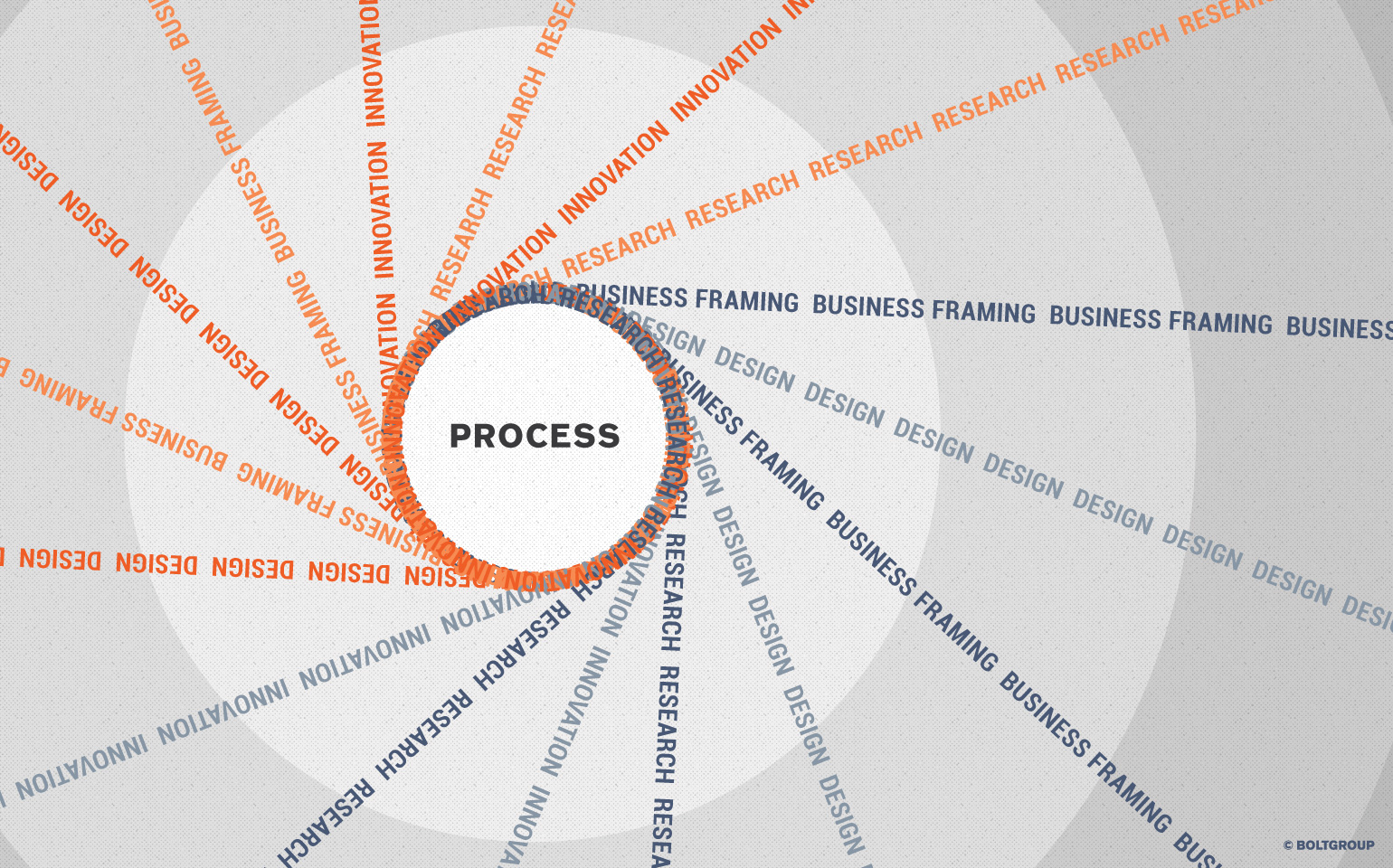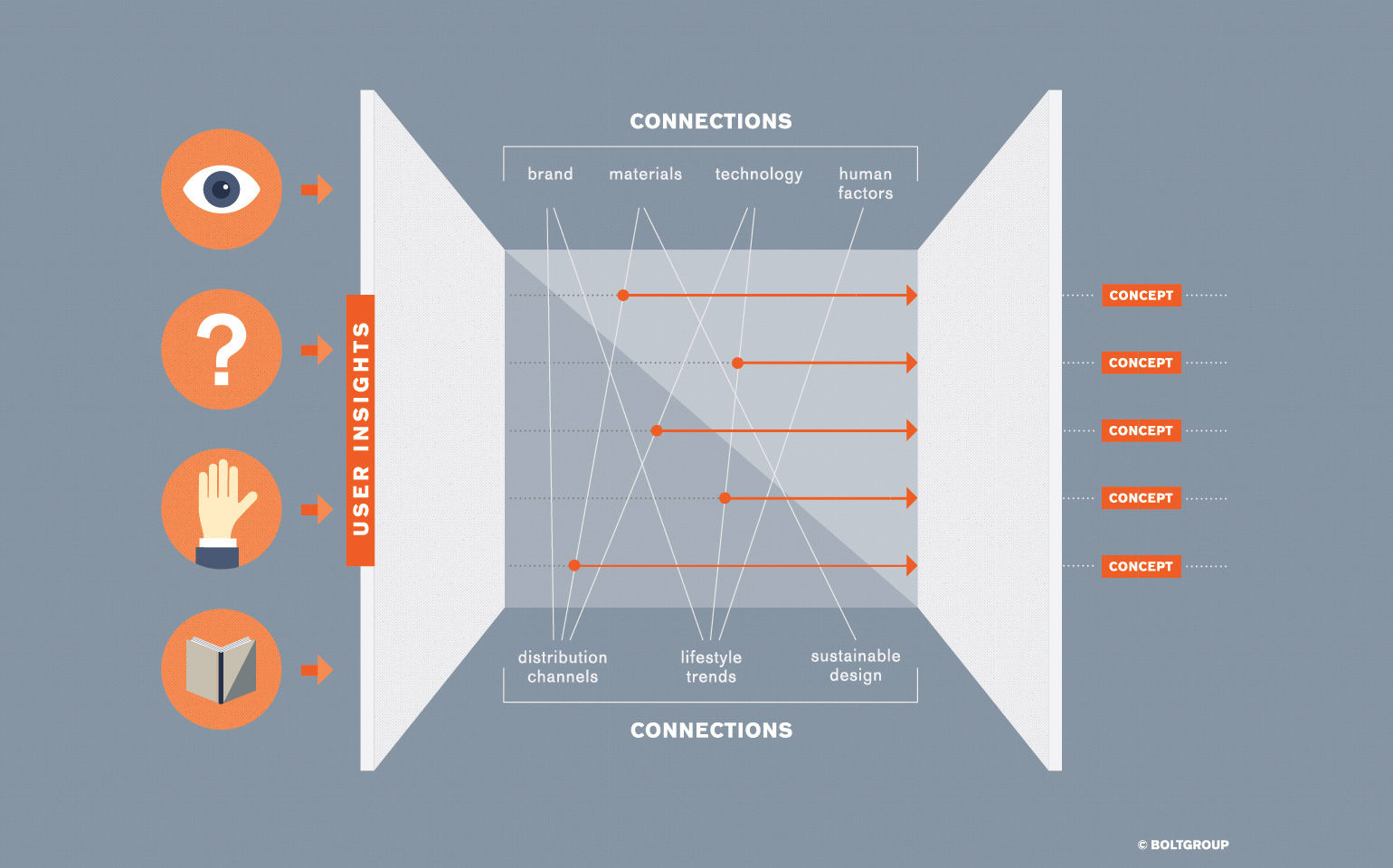Some might say the BOLTGROUP design process is a bit odd. It’s an innovation process and a design process and a research process and a business framing process, all rolled into one. Odd or not, it works amazingly well. Here are five of our secrets.
1. Ask, What Is the True Need?
Clients who engage with a design / innovation firm like ours are usually adamant about what they need. However, sometimes what they think they need is not what they truly need. The first step of an innovation and design process is to clarify the need and define the context of that need. Often the problem a client calls us about is not the actual problem that needs to be solved, but rather a symptom of the true problem. Clients know their business well, and most understand the big picture through intuition and analysis. So, together we take the first step of a good innovation process: we map out the big picture, the whole need, how the service project fits, and how they might address the rest of the story.
Some clients want new product ideas; some already have an idea and want a better embodiment of it. Some want new packaging, others want a new brand. But is what they want actually what they need? Our process helps clients walk through a self-reflection that guides them to the whole truth. It helps to step back and be able to see the root of the matter—the fundamental problem or big opportunity that will best meet their business goals.
Instead of new product ideas, they might need design language that pulls current products together in a cohesive system. Instead of a better look, they might need a better user interface, or a whole new idea. Rather than new packaging, the full answer might be a new brand strategy.
We call this first phase Framing the Need and Developing a Preliminary Strategy.
2. Make Discovery Research Iterative and Multidirectional…Just Like Design.
Iterative Research
This is a design methodology based on a cyclic process of prototyping, testing, analyzing, and refining a product or process. Much has been written about gaining empathy with the people who’ll use your products. Observing and interviewing the end user—truly walking in their shoes—has always been fundamental to our process. But to develop a successful design strategy, you need more than just interviews and observations. You need a multi-pronged research method that builds knowledge through a series of interactions. A scientist continually expands a hypothesis through iterative testing and then uses that learning to inform the next step of research. Design is, of course, iterative too. During the design phases of a project, we create multiple ideas and get them in front of people for feedback, then develop better ideas based on what we learn.
Research works the same way. We’ll use one methodology—let’s say some primary research like user observation—to understand the most salient issues around a product or a brand. Next, armed with our knowledge of the big issues, we can generate good questions to ask customers. The kind of questions that make an interview, survey, or focus group relevant. Then we might conduct more ethnography, followed by a participatory design step where we inspire enthusiast users to generate their own ideas. Then another iteration of idea testing with more users to hone the final product design. A process of ever-greater discovery.
Also important is the new way we screen consumers for research studies. We now include the outliers to see where we might be headed—people such as the mis-user, the over-the-top enthusiast, the extreme DIYer, and the early adopter.
Beyond Empathy—Secondary Research
Primary research—where we’re speaking directly with the consumer—is not always enough. BOLTGROUP also invests in secondary research to look for mega trends, identify outliers, and find technologies that might aid the innovation. Sometimes we get to know the consumer better than they know themselves. As David Epstein so aptly wrote, “Just because you’re a bird doesn’t mean you’re an ornithologist”. Being a Millennial doesn’t make you an expert on Millennials. Talking to a dozen Millennials may not give you the empathy and insights you need to explore the most meaningful innovations. But understanding them through a multifaceted blend of research methods just might.
Other Stakeholders
As designers, we see ourselves as an advocate for the end user. As such, our focus on the people who use the product is constant. It offers up the insights that lead to great design. Then again, the greatest discoveries, the biggest “Ahas”, can come from other sources. For example, some of the biggest finds exist in knowledge already held by our client, but are squirreled away in company lore or held secretly by staff. Other discovery resources include: stakeholders within the manufacturing company, resellers, installers, and maintenance people. If installers or maintenance people hate the product, its marketplace growth will be stunted and no one will know why. That’s why we start our process with a series of broad interviews, asking the right questions in the right ways, then assembling that shared knowledge into a usable library.
We call this phase Blended Research.

